
All Solutions
Page 643: Questions
Here, your teacher needs to use a resource page with the templates
for the tiles and you need to flip the tiles so that the positive
side of each tile is facing up because each tile has a positive
and a negative side.
#### (b)
The algebra tiles are marked as some parts of the expression.
We will need a total of:
$$
text{4 $x^2$ tiles, 3 $x$ tiles, 1 $y$ tile, and 7 unit tiles}
$$
which can be simplified as:
$$
color{#c34632}4x^2+3x+y+7color{white}tag{1}
$$
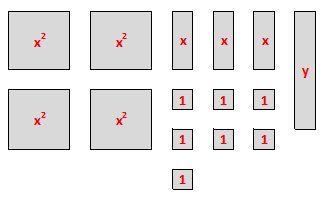
We will need a total of:
$$
text{3 $x^2$ tiles, 3 $xy$ tiles, and 6 unit tiles}
$$
which can be simplified as:
$$
color{#c34632}3x^2+3xy+6color{white}tag{1}
$$
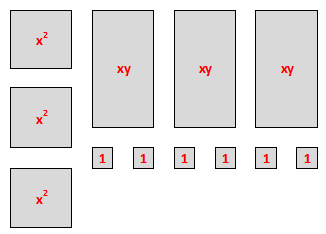
We will need a total of:
$$
text{1 $x^2$ tile, 1 $y^2$ tile, 1 $xy$ tile, 3 $x$ tiles, 4 $y$ tiles, and 2 unit tiles}
$$
which is not possible to simplify further since no tiles can be combined that will result to a new expression.
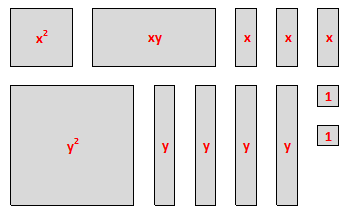
We will need a total of:
$$
text{1 $y^2$ tile, 2 $xy$ tiles, 4 $x$ tiles, $7$ $y$ tiles, and 3 unit tiles}
$$
which can be simplified as:
$$
color{#c34632}y^2+2xy+4x+7y+3color{white}tag{1}
$$
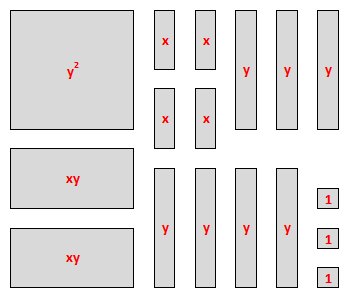
b. $3x^2+3xy+6$
c. not possible
d. $y^2+2xy+4x+7y+3$
{color{#4257b2}text{a)}}
$$
$$
begin{align*}
3x+5+x^2+y+3x^2+2& {=}quad : x^2+3x^2+3x+y+2+5\
&=4x^2+3x+y+2+5\
&={color{#c34632}4x^2+3x+y+7}
end{align*}
$$
{color{#4257b2}text{b)}}
$$
$$
begin{align*}
2x^2+1+xy+x^2+2xy+5& {=}quad : 2x^2+x^2+xy+2xy+1+5\
&=3x^2+xy+2xy+1+5 \
&=3x^2+3xy+1+5 \
&={color{#c34632}3x^2+3xy+6}
end{align*}
$$
{color{#4257b2}text{c)}}
$$
$$
text{ }2+x^2+3x+y^2+4y+xy
$$
$$
text{ }
$$
$$
color{#c34632} text{ Not:Supported }
$$
$$
text{ }
$$
$$
text{ }
$$
$$
text{ }
$$
$$
text{ }
$$
{color{#4257b2}text{d)}}
$$
$$
begin{align*}
3y+2+2xy+4x+y^2+4y+1& {=}quad : y^2+3y+2yx+4y+4x+1+2\
&=y^2+7y+2yx+4x+1+2 \
&={color{#c34632}y^2+7y+2yx+4x+3}
end{align*}
$$
color{#4257b2} text{ a) }4x^2+3x+y+7
$$
$$
color{#4257b2} text{ b) }3x^2+3xy+6
$$
$$
color{#4257b2} text{ c) Not Supported }
$$
$$
color{#4257b2} text{ d) }y^2+7y+2yx+4x+3
$$
$$
text{ }
$$
$$
text{ }
$$
$$
text{ }
$$
$$
text{(a)} 2x-3 text{(b)} -3x-(xy+2)=-3x-xy-2
$$
$$
text{(c)} x^2-(y-4)=x^2-y+4 text{(d)} 2x+2-1-3
$$
$$
color{#4257b2}text{(c)} x^2-(y-4)=x^2-y+4 text{(d)} 2x+2-1-3
$$
with the given expression.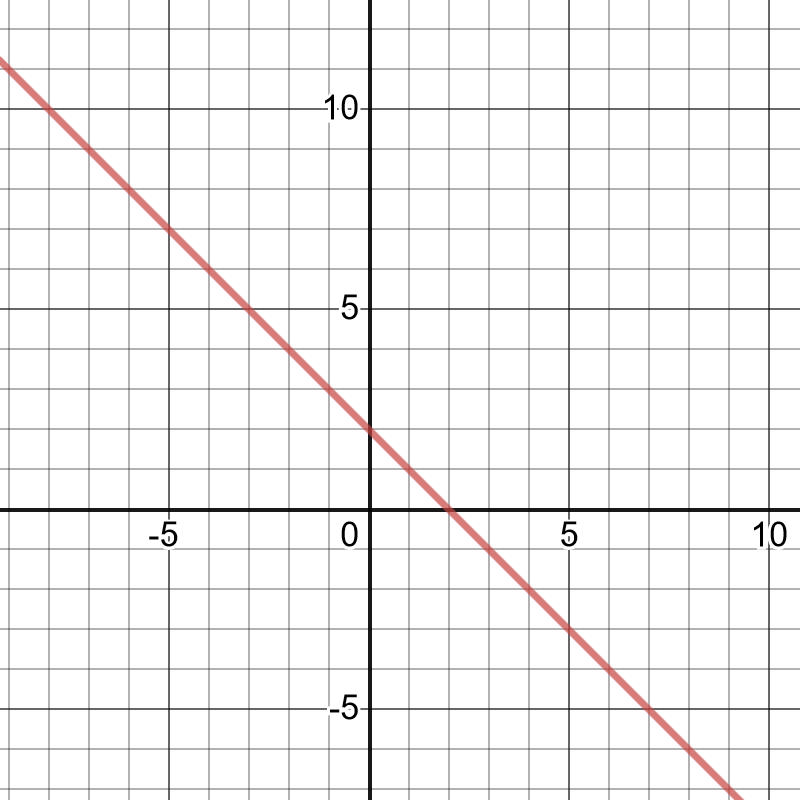
one $x$-value and one number value next to each other.
$$
x^2+y+y+xy+x+x^2+x+y+y+x^2+y^2+x^2+xy+x+x+y+xy+y+x^2+x^2
$$
$$
color{#4257b2}6x^2++y^2+3xy++4x+6y
$$
color{#4257b2}6x^2++y^2+3xy++4x+6y
$$
{color{#4257b2}text{ a) }}
$$
$$
begin{align*}
& text{Group like terms}\
&y^2+3y+2y+y+5\\
&=boxed{{color{#c34632} y^2+6y+5 } }
end{align*}
$$
{color{#4257b2}text{ b) }}
$$
$$
begin{align*}
&color{#c34632} text{Not Supported}\
end{align*}
$$
{color{#4257b2}text{ c) }}
$$
$$
begin{align*}
& text{Group like terms}\
&3xy+5x+x+3y+2+4\\
& =3xy+6x+3y+2+4 \
&=boxed{{color{#c34632} 3xy+6x+3y+6 } }
end{align*}
$$
{color{#4257b2}text{ d) }}
$$
$$
begin{align*}
& text{Group like terms}\
&m^2+3m^2+4m+2mn+m\\
& =m^2+3m^2+5m+2mn \
&=boxed{{color{#c34632} 4m^2+5m+2mn } }
end{align*}
$$
color{#4257b2} text{a)} y^2+6y+5
$$
$$
color{#4257b2} text{b) Not Supported}
$$
$$
color{#4257b2} text{c)}3xy+6x+3y+6
$$
$$
color{#4257b2} text{d)}4m^2+5m+2mn
$$
{color{#4257b2}text{ a) }}
$$
$$
begin{align*}
& text{For d=-1 we solve this}\
&-4left(-1right)+3\\
&= 4cdot :1+3 \
&=4+3 tag{Multiply the numbers}\
&=boxed{{color{#c34632} 7 } }
end{align*}
$$
$$
color{#c34632} text{}mathrm{Apply:rule}:-left(-aright)=a
$$
{color{#4257b2}text{ b) }}
$$
$$
begin{align*}
& text{For k=4 and m=-10 we solve this}\
&4-left(-10right)\\
&= 4+10 \
&=boxed{{color{#c34632} 14 } }
end{align*}
$$
$$
color{#c34632} text{}mathrm{Apply:rule}:-left(-aright)=a
$$
{color{#4257b2}text{ c) }}
$$
$$
begin{align*}
& text{For t=6 and w=-3 we solve this}\
&frac{6}{-3}\\
&= -frac{6}{3} \
&=boxed{{color{#c34632} -2 } }
end{align*}
$$
$$
color{#c34632} text{}mathrm{Apply:the:fraction:rule}:quad frac{a}{-b}=-frac{a}{b}
$$
{color{#4257b2}text{ d) }}
$$
$$
begin{align*}
& text{For x=7 and y=5 we solve this}\
&7^2+5^2\\
&= 49+25 tag{Calculate exponents} \
&=boxed{{color{#c34632} 74 } }
end{align*}
$$
color{#4257b2} text{a)}7
$$
$$
color{#4257b2} text{b)}14
$$
$$
color{#4257b2} text{c)}-2
$$
$$
color{#4257b2} text{d)}74
$$
{color{#4257b2}text{ a) }}
$$
$$
begin{align*}
&text{Adjust fractions}\
&-frac{1cdot :2}{4}+frac{3}{4}\\
&=frac{-1cdot :2+3}{4} \
&=boxed{{color{#c34632} frac{1}{4} } }
end{align*}
$$
$$
color{#c34632} text{} mathrm{Since:the:denominators:are:equal,:combine:the:fractions}:quad frac{a}{c}pm frac{b}{c}=frac{apm :b}{c}
$$
{color{#4257b2}text{ b) }}
$$
$$
begin{align*}
&text{Adjust fractions}\
&-frac{1cdot :2}{6}-frac{1}{6}\\
&=frac{-1cdot :2-1}{6} \
&=frac{-3}{6} \
&=-frac{3}{6}\
&=boxed{{color{#c34632} -frac{1}{2} } }
end{align*}
$$
$$
color{#c34632} text{} mathrm{Since:the:denominators:are:equal,:combine:the:fractions}:quad frac{a}{c}pm frac{b}{c}=frac{apm :b}{c}
$$
$$
color{#c34632} mathrm{Apply:the:fraction:rule}:quad frac{-a}{b}=-frac{a}{b} text{}
$$
$$
text{}
$$
{color{#4257b2}text{ c) }}
$$
$$
begin{align*}
&text{Convert element to fraction}\
&frac{2}{3}cdot frac{12}{1}\\
&=-frac{2cdot :12}{3cdot :1} \
&=-frac{2cdot :12}{3} \
&=-frac{24}{3} tag{Multiply the numbers}\
&=boxed{{color{#c34632} -8 } }
end{align*}
$$
$$
color{#c34632} text{}mathrm{Multiply:fractions}:quad frac{a}{b}cdot frac{c}{d}=frac{a:cdot :c}{b:cdot :d}
$$
$$
color{#c34632} text{} mathrm{Apply:rule}:1cdot :a=a
$$
{color{#4257b2}text{ d) }}
$$
$$
begin{align*}
&-frac{4}{frac{1}{2}}\\
&=-frac{4cdot :2}{1} \
&=-left(-frac{8}{1}right) \
&=frac{8}{1} \
&=boxed{{color{#c34632} 8 } }
end{align*}
$$
$$
color{#c34632} text{}mathrm{Apply:the:fraction:rule}:quad frac{a}{-b}=-frac{a}{b}
$$
$$
color{#c34632} text{}mathrm{Apply:the:fraction:rule}:quad frac{a}{frac{b}{c}}=frac{acdot :c}{b}
$$
$$
color{#c34632} text{} mathrm{Apply:rule}:-left(-aright)=a
$$
$$
color{#c34632} text{}mathrm{Apply:rule}:frac{a}{1}=a
$$
color{#4257b2} text{a)}frac{1}{4}
$$
$$
color{#4257b2} text{b)}-frac{1}{2}
$$
$$
color{#4257b2} text{c)}-8
$$
$$
color{#4257b2} text{d)}8
$$
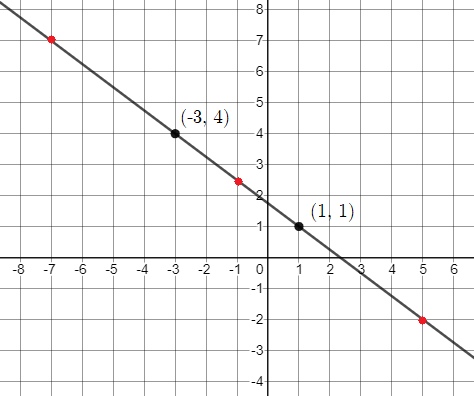
We know that,
Red tiles $+$ blue tiles $+$ beige tiles $=435$
$$
107+3b+b=435
$$
$$
107+4b=435
$$
Isolate variables on the left side as follows:
$$
4b=435-107=328
$$
$$
b=dfrac{328}{4}=82
$$
Remember that $107=82+25$
$$
color{#4257b2}435=(b+25)+3b+b
$$
color{#4257b2}435=(b+25)+3b+b
$$
They do not get or lose anything at the end.
This can be represented using math symbols
as the following expression:
$$
x-x
$$
x-x
$$
There is a built collection of tiles and written its value:
$$
5x+8y-3+4x=9x+8y-3
$$
#### (b)
You can use a different number of tiles using online tile algebra tools in order to represent
Gretchen’s expression without changing the value of the expression.
#### (c)
(i) On the following picture, there is graphed $3x+5+y$
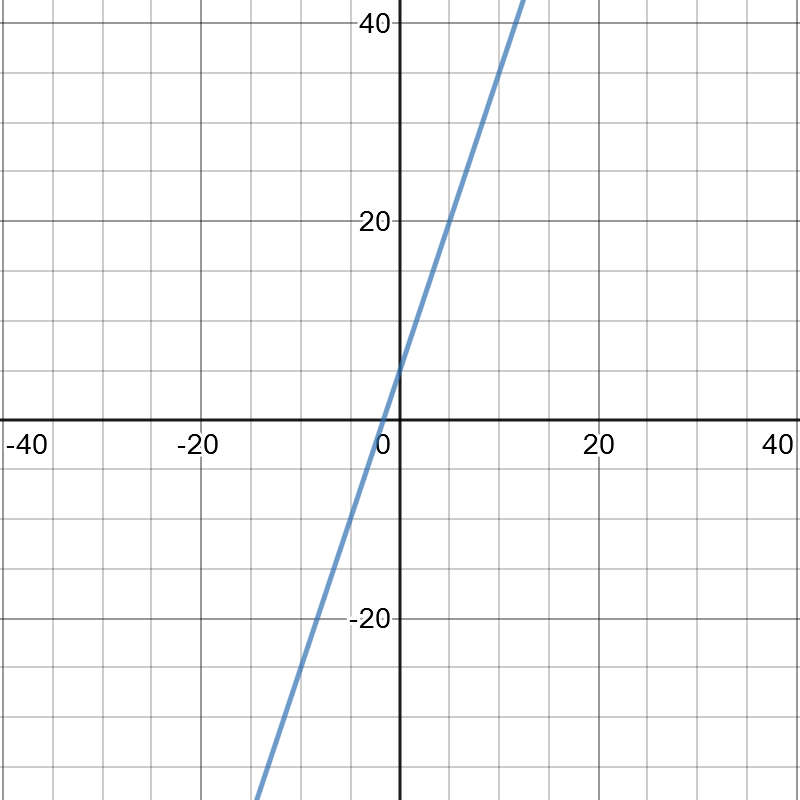
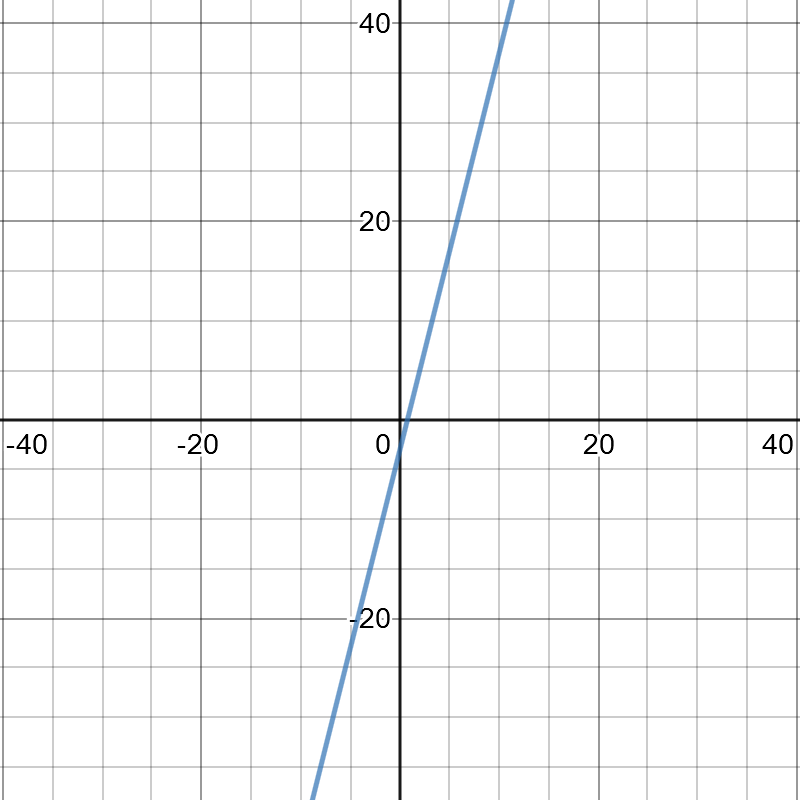
c) Use a graphing calculator
In the first step: he write the expression represent the first photo as,
$$
2x+1-(2)
$$
In the second step: he transfer the two tiles from negative side to positive side and he change the signs for it as,
$$
2x+1+(-2)
$$
In the third step: he simplify the expression in the positive side to be represent as
$$
2x-1
$$
text{color{#4257b2}Its allowed what he made to simplify the expression.}
$$
$$
largecolor{#4257b2}text{(a)}
$$
$$
x-2x-2-(-2)=x-2x-2+2=largecolor{#4257b2}-x
$$
$$
largecolor{#4257b2}text{(b)}
$$
$$
x-x+1-2-(x-3)x-x+1-2-x+3=largecolor{#4257b2}-x+2
$$
(b) $largecolor{#4257b2}-x+2$
$$
text{(a)} 3x-(2x+4)
$$
Simplify,
$$
3x-2x-4=largecolor{#4257b2}x-4
$$
$$
text{(b)} 7-(4y-3)+2y-4
$$
Simplify,
$$
7-4y+3+2y-4=largecolor{#4257b2}6-2y
$$
(b) $largecolor{#4257b2}6-2y$
of numbers, variables, and operation symbols.
Zero pairs are some kind of parts of mathematical expression but
with opposite sign, and together, they are equal to $0$.
For example, this can be explained in the following expression:
$$
8x+y-5-y=8x-5
$$
$$
color{#4257b2}text{(a)} 2x-3-(x+1)
$$
$$
=2x-3-x-1=large x-4
$$
$$
color{#4257b2}text{(b)} y-y+3-1=large2
$$
$$
color{#4257b2}text{(c)} -x-(x+2)
$$
$$
=-x-x-2=large-2x-2
$$
(b) $large 2$
(c) $large -2x-2$
$$
color{#4257b2}text{(a)} 2x-3x-3+4x^2+10+x
$$
Rearrange the tiles to groups like terms as follows:
$$
4x^2+(2x-3x+x)+(-3+10)=4x^2+0+7 large4x^2+7
$$
$$
color{#4257b2}text{(b)} -4x+y^2-9+10-x+3x-4y^2
$$
Rearrange the tiles to groups like terms as follows:
$$
4y^2+(-4x-x+3x)+(-9+10) large4y^2-2x+1
$$
$$
color{#4257b2}text{(c)} 2x^2+30y+3x^2+4x^2-y-x
$$
Rearrange the tiles to groups like terms as follows:
$$
(2x^2+4x^2+3x^2)+(30y-y)-x large9x^2+29y-x
$$
$$
color{#4257b2}text{(d)} 0-20-5xy+4y^2+10-y+xy
$$
Rearrange the tiles to groups like terms as follows:
$$
4y^2-y+(-5xy+xy)+(0-20+10) large4y^2-y-4xy-10
$$
(b) $large4y^2-2x+1$
(c) $large9x^2+29y-x$
(d) $large4y^2-y-4xy-10$
$$
color{#4257b2}f(x)=2x+3
$$
$$
{color{#4257b2}text{(a)} f(-5)}=2(-5)+3=-10+3=largecolor{#4257b2}-7
$$
$$
{color{#4257b2}text{(b)} f(-dfrac{1}{2})}=2(-dfrac{1}{2})+3=-1+3=largecolor{#4257b2}2
$$
$$
{color{#4257b2}text{(c)} f(4)}=2(4)+3=8+3=largecolor{#4257b2}11
$$
$$
{color{#4257b2}text{(d)} f(-2)}=2(-2)+3=-4+3=largecolor{#4257b2}-1
$$
(c) $largecolor{#4257b2}11$ (d) $largecolor{#4257b2}-1$
$$
color{#4257b2}text{(a)} 7-2 cdot-5
$$
Multiply from the left to right as follows:
$$
=7-(2 cdot-5)=7-(-10)=7+10=color{#4257b2}large17
$$
$$
color{#4257b2}text{(b)} 6+3(7-3 cdot2)^2
$$
Multiply from the left to the right then evaluate exponents as follows:
$$
=6+3 (7-6)^2=6+3 (1)^2=6+3=color{#4257b2}large9
$$
$$
color{#4257b2}text{(c)} 5 (-3)^2
$$
Multiply from the left to the right then evaluate exponents as follows:
$$
=5 (9)=color{#4257b2}large45
$$
color{#4257b2}text{(d)} 35 div(16-3^2) cdot2
$$
Multiply and divided from the left to the right as follows:
$$
=35 div(16-9) cdot2=35div7cdot2=5cdot2=color{#4257b2}large10
$$
$$
color{#4257b2}text{(e)} -3 cdot4+5 (-2)
$$
Multiply from the left to the right then adding and subtracting terms from left to right as follows:
$$
=-12+(-10)=-12-10=color{#4257b2}large-22
$$
$$
color{#4257b2}text{(f)} 7-6 (10-4 cdot2)div4
$$
Multiply and divided from the left to the right as follows:
$$
=7-6 (10-8)div4=7-(6cdot2)div4=7-12div4=7-3=color{#4257b2}large4
$$
(c) $color{#4257b2}large45$ (d) $color{#4257b2}large10$
(e) $color{#4257b2}large-22$ (f) $color{#4257b2}large4$
$$
color{#4257b2}text{The left figure}
$$
The perimeter of figure that mean the total lengths of figure as follows:
$$
=16+12+19+13+35+25=color{#4257b2}large120text{ units}
$$
Area of the figure can be calculated as follows:
$$
=(25cdot35)-(19cdot12)=875-228=color{#4257b2}large647text{ sq. unit}
$$
$$
color{#4257b2}text{The right figure}
$$
The perimeter of figure that mean the total lengths of figure as follows:
$$
=12+8+7+8+12+8+7+8=color{#4257b2}large70text{ units}
$$
Area of the figure can be calculated as follows:
$$
=(8+8 cdot 12+7)-(8 cdot7)-(8 cdot7)=(16cdot19)-2 cdot 56=304-112=color{#4257b2}large192text{ sq. unit}
$$
$$
text{Perimeter}=120text{ units} text{Area}=647text{ sq unit}
$$
The right figure,
$$
text{Perimeter}=70text{ units} text{Area}=192text{ sq unit}
$$
$$
1.75times6.01times10^{20+14}=1.75times6.01times10^{34}
$$
But, the calculator displayed the following:
$$
1.05175times10^{35}
$$
$$
color{#4257b2}text{(a) The left figure}
$$
$$
x+2-2-3=largecolor{#4257b2}x-3
$$
$$
color{#4257b2}text{The right figure}
$$
$$
x+2-3-(-2)=x+2-3+2=largecolor{#4257b2}x+1
$$
(b) The right figure has a largest value so, its greater than the left figure.
$$
text{(b) The right figure is greater than the left figure.}
$$
Left expression is the following:
$$
1-1+1-1+1-1+1=1
$$
Right expression is the following:
$$
1-1+1+1=2
$$
We can conclude that $2>1$, which means that expression
on the left side is greater.
#### (b)
Left expression is the following:
$$
-(-1-1)-1=1+1-1=1
$$
Right expression is the following:
$$
-(x)-x-1-1+1=x-x-1=-1
$$
We can conclude that $1>-1$, which means that expression
on the right is greater.
Left expression is the following:
$$
x-x+1-1-1=-1
$$
Right expression is the following:
$$
x-x+1+1-1-1=0
$$
We can conclude that $0>-1$, which means that expression
on the right side is greater.
Expression on the left side is:
$$
1+1+1+1+1-1-1-1-(1-1-1)=5-3-1+1+1=3
$$
Expression on the right side is:
$$
1+1+1-1-1-(1-1-1-1)=3-2-1+1+1+1=3
$$
We can conclude that those expression are equal.
#### (b)
Expression on the left side is:
$$
x+1+1+1+1-1-1-(-1+1+1)=x+4-2+1-1-1=x+1
$$
Expression on the right side is:
$$
x+1-1-1-(-1-1-1-1)=x-1+1+1+1+1=x+3
$$
We can conclude that $x+3>x+1$, which means that
the expression on the right side is greater.
Expression on the left side is:
$$
1-1-1-1-1-(-1+1)=1-4+1-1=-3
$$
Expression on the right side is:
$$
-1-1-1-(1+1+1)=-3-1-1-1=-6
$$
We can conclude that $-3>-6$, which means that expression
on the left side is greater.
#### (b)
Expression on the left side is:
$$
x+1+1+1-1-(x-x)=x+2-x+x=x+2
$$
Expression on the right side is:
$$
x-1-1-(1-1-1)=x-2-1+1+1=x-1
$$
We can conclude that $x+2>x-1$, which means that expression
on the left side is greater.
Expression on the left side is:
$$
y+1+1-1-1-1-(y+y+1+1-1)=y-1-2y-1=-y-2
$$
Expression on the right side is:
$$
1-y-1-1-(1+1+1+1-1-1)=-y-1-2=y-3
$$
We can conclude that $-y-2>-y-3$, which means that expression
on the left side is greater.
#### (d)
Expression on the left side is:
$$
x^2+1+1+1-(x+x-1)=x^2+3+1=x^2+4
$$
Expression on the right side is:
$$
x+1+1+1-(x^2+x-1-1)=x+3-x^2-x+2=-x^2+5
$$
We can conclude that $x^2+4>-x^2+5$, which means that expression
on the left side is greater.
Expression on the left side is:
$$
x-x+1-1-1-(x+y+y)=-2-x-2y
$$
Expression on the right side is:
$$
-1-y-(y+x+1)=-1-y-y-x-1=-2y-x-2
$$
We can conclude that $-2-x-2y=-2-x-2y$, which means that those
expressions are equivalent.
#### (f)
Expression on the left side is:
$$
1+1+1-1-1-(x^2+1+1+1-1-1)=1-x^2-1=-x^2
$$
Expression on the right side is:
$$
x+x+x-x+1-(x^2+x+x+x-x-1-1)=2x+1-x^2-2x+2=-x^2+3
$$
We can conclude that $-x^2+3>-x^2$, which means that expression
on the right side is greater.
c) left$=-y-2>-y-3=$right
d) left$=x^2+4>-x^2+4>-x^2+5=$right; e) left$=$right;
f) left$=-x^2<-x^2+3=$right
$$
large{color{#4257b2}text{(a)}} 2x+2-1-2=largecolor{#4257b2}2x-1
$$
$$
large{color{#4257b2}text{(b)}} x+3-x-(-1)=x+3-x+1= largecolor{#4257b2}4
$$
$$
large{color{#4257b2}text{(c)}} x^2-2-(y+2)=x^2-2-y-2= largecolor{#4257b2}x^2-y-4
$$
(c) $color{#4257b2}Large x^2-y-4$
{color{#4257b2}text{ a) }}
$$
$$
begin{align*}
& text{ Group like terms}\
&=4x^2+x+x+2x-x-3\\
&=boxed{{color{#c34632} 4x^2+3x-3 } }
end{align*}
$$
{color{#4257b2}text{ b) }}
$$
$$
begin{align*}
& text{ Group like terms}\
&=8x^2-13x^2+10x^2+3x-25x-x\\
&=8x^2-13x^2+10x^2-23x tag{Add similar elements}\
&=boxed{{color{#c34632} 5x^2-23x } }
end{align*}
$$
{color{#4257b2}text{ c) }}
$$
$$
begin{align*}
color{#c34632}text{ Not Supported}\
end{align*}
$$
{color{#4257b2}text{ d) }}
$$
$$
begin{align*}
& text{ Group like terms}\
&=4y^2-2y^2+3xy+20-3+10\\
&=2y^2+3xy+20-3+10tag{Add similar elements}\
&=boxed{{color{#c34632} 2y^2+3xy+27 } }
end{align*}
$$
color{#4257b2}text{a)}4x^2+3x-3
$$
$$
color{#4257b2}text{b)}5x^2-23x
$$
$$
color{#4257b2}text{c) Not Supported}
$$
$$
color{#4257b2} text{d)}2y^2+3xy+27
$$
$$
text{(a)} dfrac{6}{x}+9 x=3
$$
$$
dfrac{6}{x}+9=dfrac{6}{3}+9=2+9=Largecolor{#4257b2}11
$$
$$
text{(b)} -x^2+y x=2, y=1
$$
$$
-x^2+y=-(2)^2+1=-4+1=Largecolor{#4257b2}-3
$$
$$
text{(c)} -2 x y x=5, y=-3
$$
$$
-2 x y=-2 cdot 5 cdot-3=Largecolor{#4257b2}30
$$
$$
text{(d)} 2x^2-y x=-3, y=8
$$
$$
2x^2-y=2 (-3)^2-8=2 cdot9 -8=Largecolor{#4257b2}10
$$
(c) $color{#4257b2}Large30$ (d) $color{#4257b2}Large10$
Expression on the left side is:
$$
1-1-1-1-(1+1+1+1-x)=-2-4+x=x-6
$$
Expression on the right side is:
$$
x+1+1-1-(1+1+1)=x+1-3=x-2
$$
We can conclude that $x-2>x-6$, which means that
expression on the right side is greater.
#### (b)
Expression on the left side is:
$$
x+x-1-1-(1+1)=2x-2-2=2x
$$
Expression on the right side is:
$$
x+x-x-(x)=x-x=0
$$
We can conclude that $2xgeq0$, which means that
expression on the left side is greater if $x$ is positive.
(a) Is this a proportional situation?
Yes, there is a proportional situation because when the fuel of gasoline increase the distance traveled is increasing too.
(b) calculate the distance when she used $18$ gallons.
Distance $=dfrac{18cdot90}{4}=405$ miles
So she used $color{#4257b2}18$ gallons of fuel to travel $color{#4257b2}405$ miles
(b) $color{#4257b2}405$ miles
We can conclude that the line which is upper
at the $y$-axes represent company $A$ and
the other one represents the company $B$.
#### (b)
We can conclude that the profits of the company
$A$ are nonproportional situation.
#### (c)
We can conclude that for value $3$ of $x$ those
lines are intercept, so, in $3$ years those companies
will have the same profit.
#### (d)
That profit will be about $7$ thousands of dollars.
#### (e)
We can notice that profits of the company $B$ are growing
more quickly because that line has a greater slope.
c) In $3$ years; d) About $7$ thousands of dollars;
e) Profits of the Company $B$
$$
text{(a)} 3x-(2-x)+1 text{or} -5+4x+4
$$
$$
3x-2+x+1 text{or} 4x-1
$$
$$
4x-1 text{or} 4x-1
$$
$$
text{color{#4257b2}Two sides are equal.}
$$
$$
text{(b)} -1+6y-2+4x-2y text{or} x+5y-(-2+y)+3x-6
$$
$$
-3+4y+4x text{or} x+5y+2-y+3x-6
$$
$$
-3+4y+4x text{or} -4+4y+4x
$$
$$
-3 text{or} -4
$$
$text{color{#4257b2}The left side is greater than the right side}$.
text{(c)} 2x^2-2x+6-(-3x) text{or} -(3-2x^2)+5+2x
$$
$$
2x^2-2x+6+3x text{or} -3+2x^2+5+2x
$$
$$
2x^2+x+6 text{or} 2x^2+2x+2
$$
$$
x+6 text{or} x+x+2
$$
$$
6 text{or} x+2
$$
$text{color{#4257b2}Not enough information}$.
(b) The left side is greater than the right side
(c) Not enough information.
into the opposite region.
The second is zero pairs or removing an equal number of
opposite tiles that are in the same region.
The third is removing an equal number of identical tiles from
both, $”-”$ and the $”+”$ region.
And fourth is taking away from both sides.
Actually, when you are comparing expressions if you have
the same part then you can take it away.
Whatever you do to one side, you can do to the other.
$$
-2x-3+1-(3-x) text{or} 2-3-(x-2)
$$
$$
-2x-3+1-3+x text{or} 2-3-x+2
$$
$$
-x-5 text{or} -x+1
$$
$$
-5 text{or} 1
$$
$text{color{#4257b2}The right side is greater than the left side}$.
subtract that one from $”-“$ region and then from
both expressions she removed the same parts and
then simplified it and again removed same parts and
on that way, she gets the result.
same parts of both expressions and simplified.
$$
text{(a)} x^2-x^2+2x-(x^2-1+1) text{or} x+3-1-(x^2+1)
$$
$$
x^2-x^2+2x-x^2+1-1 text{or} x+3-1-x^2-1
$$
$$
2x-x^2 text{or} x-x^2+1
$$
$$
2x text{or} x+1
$$
$$
x+x text{or} x+1
$$
$$
x text{or} 1
$$
$text{color{#4257b2}Not enough information}$.
$$
text{(b)} 5x+1-2-(3x+2) text{or} 2x+3-1-(2)
$$
$$
5x+1-2-3x-2 text{or} 2x+3-1-2
$$
$$
2x-3 text{or} 2x+0
$$
$$
-3 text{or} 0
$$
$text{color{#4257b2}The right side is greater than the left side}$.
text{(c)} 5-(2y-4)-2 text{or} -y-(1+y)+4
$$
$$
5-2y+4-2 text{or} -y-1-y+4
$$
$$
-2y+7 text{or} -2y+3
$$
$$
7 text{or} 3
$$
$text{color{#4257b2}The left side is greater than the right side}$.
$$
text{(d)} 3xy+9-4x-7+x text{or} -2x+3xy-(x-2)
$$
$$
3xy-3x+2 text{or} -2x+3xy-x+2
$$
$$
3xy-3x+2 text{or} 3xy-3x+2
$$
$text{color{#4257b2}The two sides are equals}$.
(b) $text{color{#4257b2}The right side is greater than the left side}$.
(c) $text{color{#4257b2}The left side is greater than the right side}$.
(d) $text{color{#4257b2}The two sides are equal}$.
$$
text{(a)} 2x+1-2-(x+1) text{or} x+1-3-(6)
$$
$$
2x+1-2-x-1 text{or} x+1-3-6
$$
$$
x-2 text{or} x-8
$$
$$
-2 text{or} -8
$$
$text{color{#4257b2}The left side is greater than the right side}$
$$
text{(b)} 2x+1-3-(x-x+4) text{or} x+3-1-(4-2-x)
$$
$$
2x+1-3-x+x-4 text{or} x+3-1-4+2+x
$$
$$
2x-6 text{or} 2x+0
$$
$$
-6 text{or} 0
$$
$text{color{#4257b2}The right side is greater than the left side}$.
(b) $text{color{#4257b2}The right side is greater than the left side}$.
$color{#4257b2}text{(a)} f(x)=2+3x x=4$
Substitute value of $x$ in the function as follows:
$$
f(4)=2+3 cdot4=2+12=Large14
$$
$$
f(4)=14
$$
$color{#4257b2}text{(b)} a=4-5 c c=-dfrac{1}{2}$
$text{Substitute value of $c$ as follows}$:
$$
a =4-5 cdotdfrac{-1}{2}=4-dfrac{-5}{2}=4+dfrac{5}{2}
$$
$$
a =dfrac{8+5}{2}=dfrac{13}{2}=6.5
$$
$$
a=6.5
$$
$color{#4257b2}text{(c)} n=3 d^2 d=-5$
Substitute value of $d$ as follows:
$$
begin{align*}
n &=3 cdot(-5)^2=3 cdot25
\ \
n &=Large75
end{align*}
$$
Substitute value of $x$ in the function as follows:
$$
f(-1)=-4 (-1-2)=-4 cdot-3=Large12
$$
$$
f(-1)=12
$$
$color{#4257b2}text{(e)} 3+k=t t=14$
Substitute value of $t$ as follows:
$$
3+k=14 k=14-3
$$
$$
k=Large11
$$
(c) $n=75$ (d) $h(-1)=12$
(e) $k=11$
Assume the number of adults is $color{#4257b2}x$ and number of student is $color{#4257b2}150+x$
Total of people attended the play is $color{#4257b2}1220$
$$
1220=150+x+x=150+2x
$$
Isolate the variables on the left side as follows:
$$
2x=1220-150=1070
$$
$$
x=dfrac{1070}{2}=535
$$
The number of adults is $535$
The number of student is $535+150=color{#4257b2}685$
$$
x+x-1-(1)=2x-2
$$
On the right side, expression is:
$$
x+x+1-1-(1)=2x-1
$$
We can conclude that $2x-2<2x-1$, so, expression on the right side is greater.
(a) Is this a proportional situation?
Yes, there is a proportional situation because when he read more pages, so he will take more time.
(b) calculate the time which needed to read entire novels?
Time $=dfrac{350cdot2}{75}=9.33$ hours
So he read the entire novels which contains $color{#4257b2}350$ pages in $color{#4257b2}9.33$ hours.
(b) $color{#4257b2}9.33$ hours.
(a) The perimeter of the large outer rectangle.
$$
=5+7+6+8+7+5+8+6=color{#4257b2}large52text{ units}
$$
(b) Total area of the figure can be calculated as follows:
$$
=30+40+(7cdot8)+(6cdot7)=30+40+56+42=color{#4257b2}large168text{ sq. unit}
$$
(b) $color{#4257b2}168$ sq. unit
$$
x+1-(1-2x) text{or} 3+x-1-(x-4)
$$
$$
x+1-1+2x text{or} 3+x-1-x+4
$$
$$
3x text{or} 6
$$
$text{color{#4257b2}Not enough information}$.
In this case the left side has a variable and the right side has a constant number, so that it is not possible to determine which side is greater.
$$
x text{or} 5
$$
(a) If the left expression is smaller than the right expression, what about value of $x$.
The value of $x$ should be less than $5$ to make the left side is less than the right side.
$$
text{color{#4257b2}(b) If the left expression is greater than the right expression, what about value of $x$.
\
\
The value of $x$ should be more than $5$ to make the left side is greater than the right side.}
$$
(c) If the left expression is equal the right expression, what about value of $x$.
The value of $x$ should be equal $5$ to make the left side is equal the right side.
text{color{#4257b2}(a) $xleq5$ (b) $xgeq5$ (c) $x=5$}
$$
Here we get following equation which is needed to be solved for $x$:
$$
begin{align*}
x+1+1+1-1-1-(-x-x+1)&=1+1+1+1+1+1-(-x+1)\
x+1+2x-1&=7+x-1\
3x=&x+6\
2x=&6\
x=&3\
end{align*}
$$
#### (b)
Here we have following tiles:
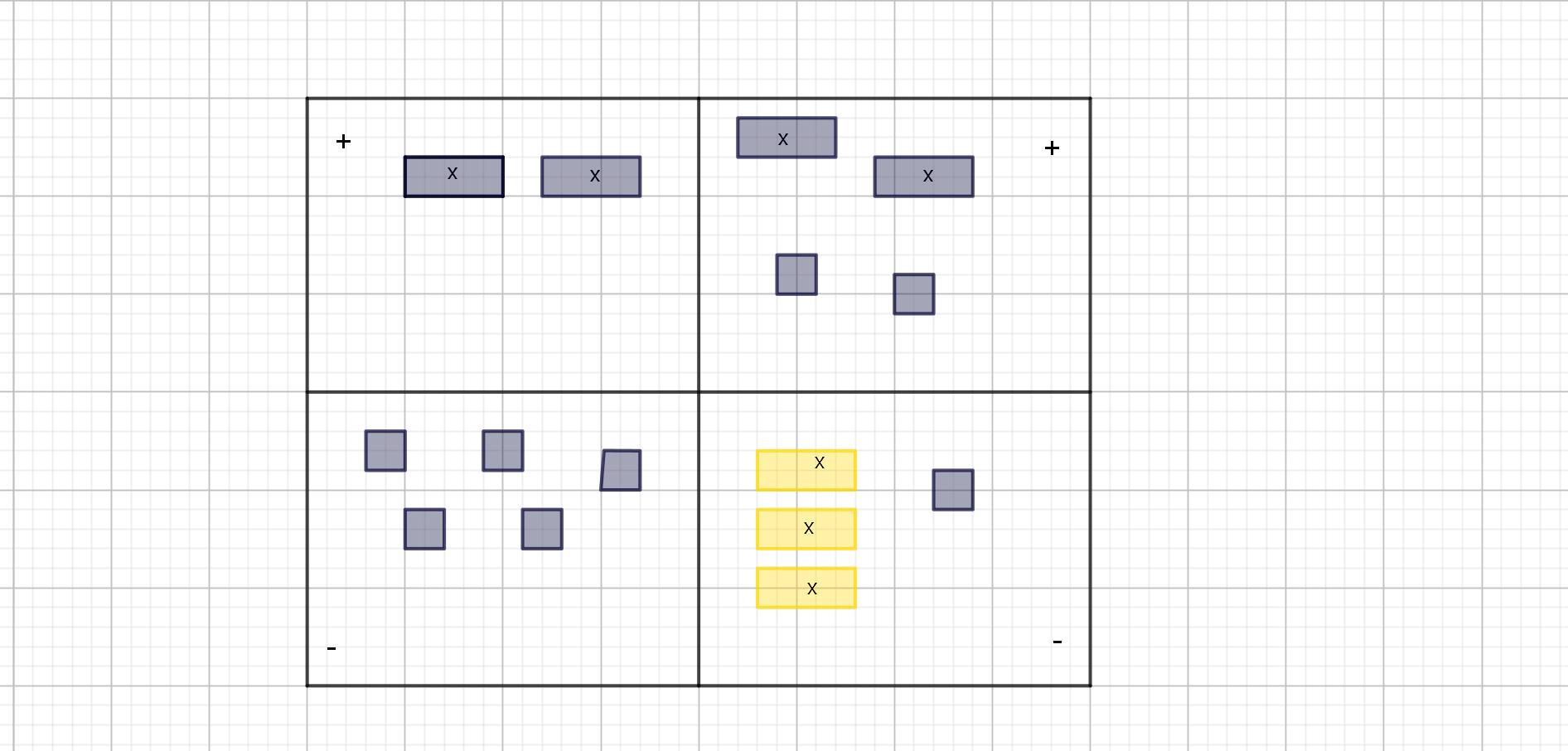
$$
-3x=6
$$
to get the value of $x$.
$$
color{#4257b2}text{(a)} 1+2x-x=x-5+x
$$
Isolate the variables on the left side and the numbers on the right side as follows:
$$
begin{align*}
2x-x-x-x &=-5-1 2x-3-x=-6
\ \
-x &=-6 x=6
end{align*}
$$
$$
color{#4257b2}text{(b)} 3x-7=2
$$
Isolate the variables on the left side and the numbers on the right side as follows:
$$
begin{align*}
3x &=2+7 3x=9
\ \
x &=dfrac{9}{3} x=3
end{align*}
$$
color{#4257b2}text{(c)} 3+2x-(x+1)=3x-6
$$
$$
3+2x-x-x=3x-6
$$
Isolate the variables on the left side and the numbers on the right side as follows:
$$
begin{align*}
2x-x-x-3x &=-6-3 -3x=-9
\ \
x &=dfrac{-9}{-3} x=3
end{align*}
$$
$$
color{#4257b2}text{(d)} 3-2x=2x-5
$$
Isolate the variables on the left side and the numbers on the right side as follows:
$$
begin{align*}
-2x-2x &=-5-3 -4x=-8
\ \
x &=dfrac{-8}{-4} x=2
end{align*}
$$
color{#4257b2}text{(e)} -(x+3-x)=2x-7
$$
$$
-x-3+x=2x-7
$$
Isolate the variables on the left side and the numbers on the right side as follows:
$$
begin{align*}
-x+x-2x &=-7+3 -2x=-4
\ \
x &=dfrac{-4}{-2} x=2
end{align*}
$$
$$
color{#4257b2}text{(f)} -4+2x+2=x+1+x
$$
Isolate the variables on the left side and the numbers on the right side as follows:
$$
begin{align*}
2x-x-x &=1+4-2 0=3
\ \
text{color{#4257b2}Not supported}
end{align*}
$$
(d) $x=2$ (e) $x=2$ (f) Not supported
$$
text{(a)} 4-3-(x+2-2) text{or} 3-2-x-(1-3)
$$
$$
4-3-x-2+2 text{or} 3-2-x-1+3
$$
$$
1-x text{or} 3-x
$$
$$
1 text{or} 3
$$
$text{color{#4257b2}The right side is greater than the left side}$.
$$
text{(b)} -2x+2-4-(1-1) text{or} -x+2-2-(x+2-1)
$$
$$
-2x+2-4-1+1 text{or} -x+2-2-x-2+1
$$
$$
-2x-2 text{or} -2x-1
$$
$$
-2 text{or} -1
$$
$text{color{#4257b2}The right side is greater than the left side}$.
(b) The right side is greater than the left side.
Assume the second number is $color{#4257b2}x$ and the first number is $color{#4257b2}x-14$
When adds is $x+x-14=40$
$$
2x-14=40
$$
Isolate the variables on the left side and the numbers on the right side as follows:
$$
2x=40+14=54 x=dfrac{54}{2}
$$
$$
x=27
$$
The second number is $color{#4257b2}27$
The first number is $27-14=color{#4257b2}13$
text{color{#4257b2}$$13 text{and} 27$$}
$$
{color{#4257b2}text{ a) }}
$$
$$
begin{align*}
& text{Group like terms}\
&=3y-y+5x-7x+3\\
&=2y+5x-7x+3 tag{Add similar elements} \
&=boxed{{color{#c34632} 2y-2x+3 } }
end{align*}
$$
{color{#4257b2}text{ b) }}
$$
$$
begin{align*}
& text{Remove parentheses}\
&=-1+5x-2x+2x^2+7\\
&=-1+3x+2x^2+7 tag{Add similar elements} \
&=2x^2+3x-1+7tag{Group like terms}\
&=boxed{{color{#c34632} 2x^2+3x+6 } }
end{align*}
$$
{color{#4257b2}text{ c) }}
$$
$$
begin{align*}
& text{Group like terms}\
&=6x-4x-2x+2-1-3+2\\
&=2-1-3+2 tag{Add similar elements} \
&=boxed{{color{#c34632} 0 } }
end{align*}
$$
{color{#4257b2}text{ d) }}
$$
$$
begin{align*}
& text{Group like terms}\
&=frac{2}{3}x+frac{1}{3}x-3y+2y\\
&=1cdot :x-3y+2y tag{Add similar elements} \
&=1cdot :x-y tag{Add similar elements} \
&=boxed{{color{#c34632} x-y } }
end{align*}
$$
color{#4257b2} text{a)} 2y-2x+3
$$
$$
color{#4257b2} text{b)} 2x^2+3x+6
$$
$$
color{#4257b2} text{c)} 0
$$
$$
color{#4257b2} text{d)}x-y
$$
{color{#4257b2}text{a)}}
$$
$$
begin{align*}
-frac{2}{3}+frac{4}{5}& {=}quad : -frac{2cdot :5}{15}+frac{4cdot :3}{15}\
&=frac{-2cdot :5+3cdot :4}{15} \
&={color{#c34632}frac{2}{15}}
end{align*}
$$
{color{#4257b2}text{b)}}
$$
$$
begin{align*}
2-frac{3}{8}& {=}quad :frac{2}{1}-frac{3}{8}\
&=frac{2cdot :8}{8}-frac{3}{8} \
&=frac{2cdot :8-3}{8} \
&={color{#c34632}frac{13}{8}}
end{align*}
$$
{color{#4257b2}text{c)}}
$$
$$
begin{align*}
-frac{3}{5}cdot :10& {=}quad : frac{3}{5}cdot frac{10}{1}\
&=-frac{3cdot :10}{5cdot :1} \
&=-frac{3cdot :10}{5} \
&=-frac{30}{5} \
&={color{#c34632}-6}
end{align*}
$$
{color{#4257b2}text{d)}}
$$
$$
begin{align*}
mathrm{frac{2}{3}div :-2}& {=}quad : -frac{2}{2cdot :3}\
&=-frac{2}{6} \
&={color{#c34632}-frac{1}{3}}
end{align*}
$$
color{#4257b2}text{ a) } frac{2}{15}
$$
$$
color{#4257b2}text{ b) } frac{13}{8}
$$
$$
color{#4257b2} text{ c) }-6
$$
$$
color{#4257b2} text{ d) } -frac{1}{3}
$$
$$
text{ }
$$
$$
text{ }
$$
$$
text{ }
$$
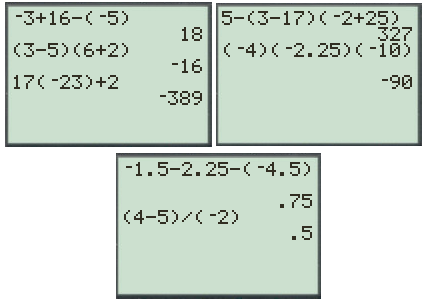
begin{align*}
&text{a. }-3+16-(-5) & &to & &text{4. 18}\
&text{b. }(3-5)(6+2) & &to & &text{1. $-16$}\
&text{c. }17(-23)+2 & &to & &text{7. $389$}\
&text{d. }5-(3-17)(-2+25) & &to & &text{2. $327$}\
&text{e. }(-4)(-2.25)(-10) & &to & &text{5. $-90$}\
&text{f. }-1.5-2.25-(-4.5) & &to & &text{6. $0.75$}\
&text{g. }dfrac{4-5}{-2} & &to & &text{3. $0.5$}
end{align*}
$$
b. 1
c. 7
d. 2
e. 5
f. 6
g. 3
$color{#4257b2}text{(a)} y=2+4 cdot 3x x=-6$
$text{Substitute value of $x$ as follows}$:
$$
y =2+(4 cdot3 cdot -6)=2+(-72)=2-72
$$
$$
y=-70
$$
$color{#4257b2}text{(b)} g(x)=(x-3)^2 g (-9)$
Substitute value of $x$ in the function as follows:
$$
f(-9)=(-9-3)^2=(-12)^2=Large144
$$
$$
f(-9)=144
$$
Substitute value of $c(x)$ in the function as follows:
$$
3.5=x-2=
$$
Isolate the variables on the left side as follows:
$$
-x=-2-3.5=-5.5
$$
$$
x=5.5
$$
$color{#4257b2}text{(d)} y=5x^2-4 x=-2$
$text{Substitute value of $x$ as follows}$:
$$
y =5 (-2)^2-4=5 cdot4-4=20-4
$$
$$
y=16
$$
(c) $x=5.5$ (d) $y=16$
$$
color{#4257b2}text{(a)} 1-2-1=4+2x-(x-2x-2)
$$
$$
1-2-1=4+2x-x+2x+2
$$
Isolate the variables on the left side as follows:
$$
-2x-2x+x=4+2-1+2+1
$$
$$
-3x=8 x=dfrac{8}{-3} x=dfrac{-8}{3} x=-2.66
$$
$$
color{#4257b2}text{(b)} 2x-(y-2)=-2-(-y)
$$
$$
2x-y+2=-2+y
$$
Isolate the variables on the left side as follows:
$$
2x-y-y=-2-2 2x-2y=-4
$$
Divided the entire equation by $2$ as follows:
$$
x-y=-4
$$
Not supported
$$
color{#4257b2}text{(a)} x^2+2x-(-2x)=x-2-(-1-x^2)
$$
$$
x^2+2x+2x=x-2+1+x^2
$$
Isolate the variables on the left side as follows:
$$
x^2+2x+2x-x-x^2=2+1
$$
$$
3x=3 x=dfrac{3}{3} x=1
$$
$$
color{#4257b2}text{(b)} x+1-1-(-2)=x+3-(1-x)
$$
$$
x+1-1+2=x+3-1+x
$$
Isolate the variables on the left side as follows:
$$
x-x-x=3-1-2+1-1 -x=0 x=0
$$
$$
color{#4257b2}text{(c)} 1-4-x-(4-1)=-x-2-(4)
$$
$$
1-4-x-4+1=-x-2-4
$$
Isolate the variables on the left side as follows:
$$
-x+x=-2-4+4+4-1-1 0=0
$$
No variables value in the equation to be calculated, because the left side and right side are equals zero.
{color{#4257b2}text{ a) }}
$$
$$
begin{align*}
& text{Subtract 2 from both sides}\
&-x+2-2=4-2\\
&-x=2 tag{Simplify} \
&frac{-x}{-1}=frac{2}{-1} tag{Divide both sides by -1}\
&boxed{{color{#c34632} x=-2 } }
end{align*}
$$
{color{#4257b2}text{ b) }}
$$
$$
begin{align*}
& text{Group like terms}\
&4x+x-2=2x+8+3x\\
&5x-2=2x+8+3x tag{Add similar elements} \
&5x-2=2x+3x+8 tag{Group like terms}\
&5x-2=5x+8 tag{Add similar elements}\
&5x-2+2=5x+8+2 tag{Add 2 to both sides}\
&5x=5x+10 tag{Simplify}\
&5x-5x=5x+10-5x tag{Subtract 5x from both sides}\
& 0=10 tag{Simplify}\
&color{#c34632} text{No Solution}\
end{align*}
$$
{color{#4257b2}text{ c) }}
$$
$$
begin{align*}
& text{Group like terms}\
&4y+y-9=6\\
&5y-9+9=6+9tag{Add 9 to both sides}\
&5y=15 tag{Simplify}\
&frac{5y}{5}=frac{15}{5}tag{Divide both sides by 5}\
&boxed{{color{#c34632} y=3 } }
end{align*}
$$
{color{#4257b2}text{ d) }}
$$
$$
begin{align*}
& text{Expand}\
&3y+7=y+1\\
&3y+7-7=y+1-7tag{Subtract 7 from both sides}\
&3y=y-6 tag{Simplify}\
&3y-y=y-6-ytag{Subtract y from both sides}\
&2y=-6 tag{Simplify}\
&frac{2y}{2}=frac{-6}{2} tag{Divide both sides by 2}\
&boxed{{color{#c34632} y=-3 } }
end{align*}
$$
color{#4257b2} text{a)}x=-2
$$
$$
color{#4257b2} text{b) No Solution}
$$
$$
color{#4257b2} text{c)}y=3
$$
$$
color{#4257b2} text{d)}y=-3
$$
Second one is zero pairs, or, removing an equal number of oppposite tiles that are in the same region.
Third is removing an equal number of identical tiles from both, the $”-”$ and the $”+”$ region.
And fourth is taking away from both sides. Actually, when you are comparing expressions, if you have the same part then you can take it away. Whatever you do to one side, you can do to the other.
Here we get the following equation which is needed
to be solved for $x$:
$$
begin{align*}
-1-1+1+x-(1+1+1-x)&=1+1+1+1+1+1-(1-1)\
-1+x-3+x&=6\
2x&=10\
x&=5\
end{align*}
$$
So, the solution of this equation is $x=5$.
We will solve the given equation moving $x$ to the one side of equality:
$$
begin{align*}
4x&=-8\
x&=-2\
end{align*}
$$
#### (c)
Here, $-$ in front of the expression $(x-3)$ means that in that case,
the expression is equal to:
$$
-(x-3)=-x+3
$$
The previous part actually explains the required equality.
$$
text{(a)} x-x+1-3-(2-1-x) text{or} x+2-2-(-3)
$$
$$
x-x+1-3-2+1+x text{or} x+2-2+3
$$
$$
x-x+x+1-3-2+1 text{or} x+2-2+3
$$
$$
x-3 text{or} x+3
$$
$$
-3 text{or} 3
$$
$text{color{#4257b2}The right side is greater than the left side}$
$$
text{(b)} x+2-2-(-2) text{or} 2-3-(2-x-1)
$$
$$
x+2-2+2 text{or} 2-3-2+x+1
$$
$$
x+2 text{or} x-2
$$
$$
2 text{or} -2
$$
$text{color{#4257b2}The left side is greater than the right side}$.
(b) $text{color{#4257b2}The left side is greater than the right side}$.
$$
text{(a)} 6m+2n^2 m=7, n=3
$$
$$
(6 cdot7)+(2 cdot3^2)=42+(2 cdot9)=42+18=Largecolor{#4257b2}60
$$
$$
text{(b)} dfrac{5x}{3}-2 x=1
$$
$$
dfrac{5 cdot1}{3}-2=dfrac{5}{3}-dfrac{2}{1}=dfrac{5-6}{3}=Largecolor{#4257b2}-dfrac{1}{3}
$$
$$
text{(c)} 6x^2-dfrac{x}{5} x=10
$$
$$
(6 cdot 10^2)-dfrac{10}{5}=(6 cdot100)-dfrac{2}{1}=600-2=Largecolor{#4257b2}598
$$
$$
text{(d)} (k-3)(k+2) k=1
$$
$$
(1-3)(1+2)=-2 cdot3=Largecolor{#4257b2}-6
$$
(c) $598$ (d) $-6$
$$
color{#4257b2}text{(a)} 4x+7+3y-(1+3y+2x)
$$
$$
4x+7+3y-1-3y-2x
$$
Add similar items to groups as follows:
$$
4x-2x-3y+3y+7-1
$$
$$
2x+6
$$
$$
color{#4257b2}text{(b)} 16x^2-4x+5-(16x^2-8x)+1
$$
$$
16x^2-4x+5-16x^2+8x+1
$$
Add similar items to groups as follows:
$$
16x^2-16x^2-4x+8x+5+1
$$
$$
4x+6
$$
color{#4257b2}text{(c)} (32x-7y)-(28x-11y)
$$
$$
32x-7y-28x+11y
$$
Add similar items to groups as follows:
$$
32x-28x+11y-7y
$$
$$
4x+4y
$$
$$
color{#4257b2}text{(d)} y+2+2y+2+2y-2x+y
$$
Add similar items to groups as follows:
$$
y+2y+2y+y-2x+4
$$
$$
6y-2x+4
$$
text{color{#4257b2}(a) $2x+6$ (b) $4x+6$
\
\
(c) $4x+4y$ (d) $6y-2x+4$}
$$
$$
text{color{#4257b2}(a) How much does one gallon of gas cost?}
$$
Let one gallon of gas has cost of $n$ so,
$$
12 cdot n=39.48 n= dfrac{39.48}{12}=3.29text{ dollars}
$$
$therefore$ One gallon of gas has cost of $3.29text{ dollars}$
$$
text{color{#4257b2}(b) How much will it cost if he needed $15$ gallons of gas?}
$$
Let one gallon of gas has cost of $3.29text{ dollars}$ so,
$$
15 cdot 3.29=49.35text{ dollars}
$$
$$
text{color{#4257b2}(c) How much gas it mopped needed if it cost $13.16$ dollars}
$$
Let one gallon of gas has cost of $3.29text{ dollars}$ so,
$$
x cdot 3.29=13.16 x= dfrac{13.16}{3.29}=4text{ gallons}
$$
(c) $4text{ gallons.}$
On the following picture there are graphed figures $4$ and $5$:
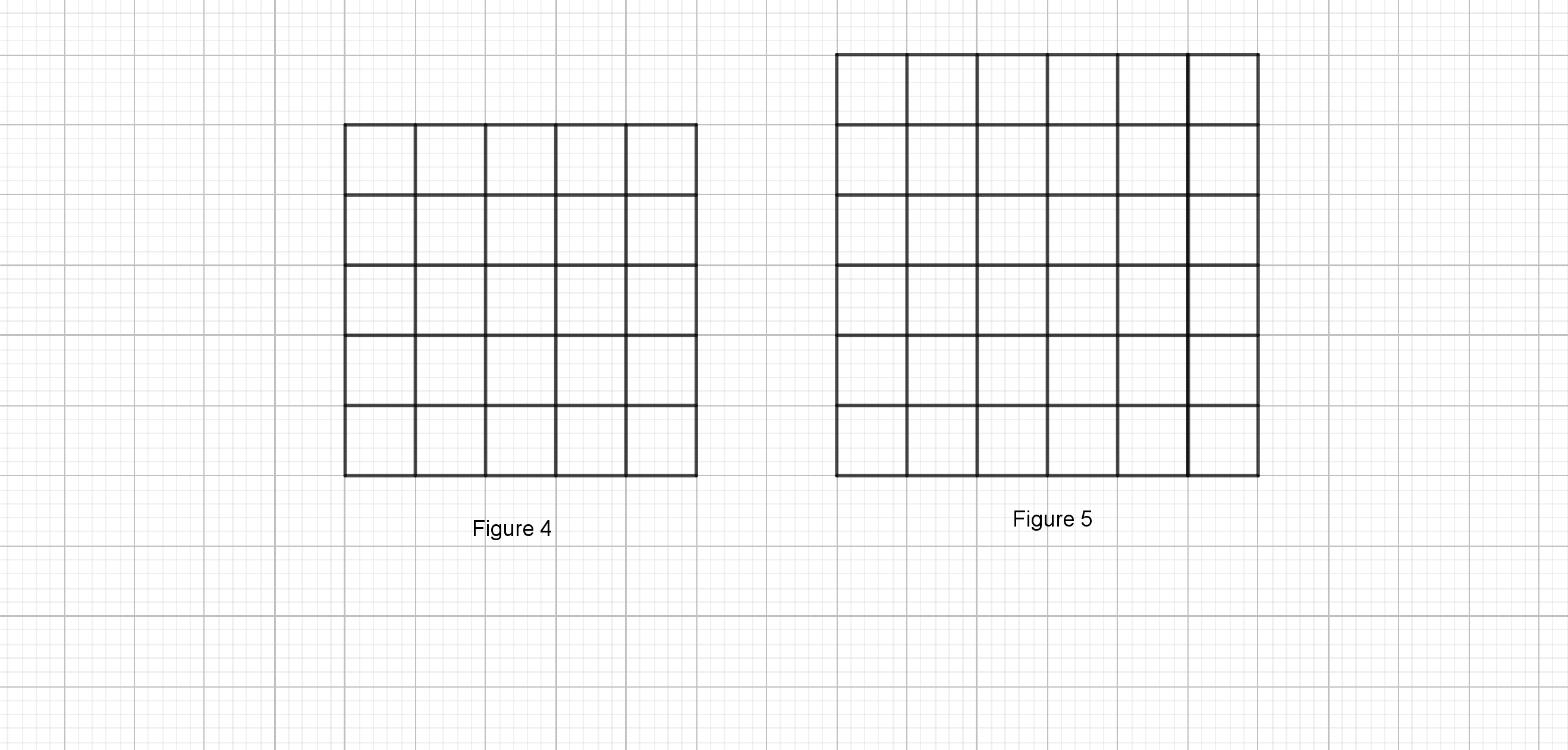
Conclusion is that Figure $10$ will have $11$ tiles on each side, while Figure $100$ will have $101$ tile on each side.
#### (c)
Here, each following figure has $4$ more patterns than previous, which means that Figure $5$ will have $21$ tiles, while Figure $8$ will have $33$ tiles.
Required equation is following:
$$
1+1+1+1+1+1-(x+x+x+1)=-x-x-3
$$
#### (b)
We will solve previous equation putting $x$ on one side of it and get:
$$
6-3x-1=-2x-3
$$
$$
-x=-8
$$
$$
x=8
$$
So, solution is $x=8$.
#### (c)
Here, Luke actually got follwing:
$$
-x=-8
$$
All he need to do is to multiply both sides by $-1$ and then get solution, $x=8$.
You need to add this move to the solution of task $60$.
#### (e)
You can substitute $8$ for $x$ in original equation from part (a) and check if both sides are equal in this case.
We can substitute $100$ for $x$ in the given
equation and check it, and get:
$$
3cdot100-2=8
$$
$$
298=8
$$
But, $298ne8$, so, the conclusion is that Preston
is not correct.
#### (b)
We can substitute $4$ for $x$ in the given equation
and check it, so, we get:
$$
2cdot4+3-4=3cdot4-5
$$
$$
7=7
$$
So, the conclusion is that Edwin is correct.
#### (c)
We will solve the equation from part a) on the
following way:
$$
3x=10
$$
$$
x=dfrac{10}{3}
$$
So, the solution for this part is $x=dfrac{10}{3}$.
c) $x=dfrac{10}{3}$ is a solution.
to get the value of $x$.
$$
color{#4257b2}text{(a)} 3x+4=x+8
$$
Isolate the variables on the left side and the numbers on the right side as follows:
$$
begin{align*}
3x-x&=8-4 2x=4
\ \
x &=dfrac{4}{2} x=2
\
end{align*}
$$
$$
color{#4257b2}text{(b)} 4-2y=y+10
$$
Isolate the variables on the left side and the numbers on the right side as follows:
$$
begin{align*}
-2y-y &=10-4 -3y=6
\ \
y &=dfrac{6}{-3} y=dfrac{-6}{3} y=-2
end{align*}
$$
color{#4257b2}text{(c)} 2x-4-5x=-(x+8)
$$
Isolate the variables on the left side and the numbers on the right side as follows:
$$
begin{align*}
2x-5x-x &=-8+4 -4x=-4
\ \
x &=dfrac{-4}{-4} x=1
\
end{align*}
$$
$$
color{#4257b2}text{(d)} -2-3k-2=-2k+8-k
$$
Isolate the variables on the left side and the numbers on the right side as follows:
$$
begin{align*}
-3k+2k+k &=8+2+2 0=12
\ \
text{No solution}
end{align*}
$$
(b) $x=1$ (d) No solution
$$
-2x=-4
$$
$$
x=2
$$
We got that solution is $x=2$.
We put $x$ on the one side of the equation,
and on that way we solved it.
$$
color{#4257b2}text{(a)} 2x+3-(x-1)=2x-2-(-x)
$$
Change subtraction to adding the opposite as follows:
$$
2x+3-x+1=2x-2+x
$$
Isolate the variables on the left side as follows:
$$
2x-x-2x-x=-2-1-3
$$
$$
-2x=-6 x=dfrac{-6}{-2} x=3
$$
$$
color{#4257b2}text{(b)} 2x-(x-2)=-2-(x-1)
$$
Change subtraction to adding the opposite as follows:
$$
2x-x+2=-2-x+1
$$
Isolate the variables on the left side as follows:
$$
2x-x+x=-2+1-2 2x=-3
$$
$$
x=dfrac{-3}{2} x=-1.5
$$
color{#4257b2}text{(c)} 3c-7=-c+1
$$
Isolate the variables on the left side as follows:
$$
3c+c=1+7
$$
$$
4c=8 c=dfrac{8}{4} c=2
$$
$$
color{#4257b2}text{(d)} -2+3x=2x+6+x
$$
Isolate the variables on the left side as follows:
$$
3x-2x-x=6+2 0=8
$$
No solution
(c) $c=2$ (d) Not solution
$$
color{#4257b2}text{(a)} 3x+7=x-1 text{When} x=-4
$$
Substitute the value of $x=-4$ in the equation as follows:
$$
(3 cdot-4)+7=-4-1 -12+7=-5 -5=-5
$$
The left side is equal the right side, so the given solution is correct.
$$
color{#4257b2}text{(b)} -2x-4=-4x+3 text{When} x=3
$$
Substitute the value of $x=3$ in the equation as follows:
$$
(-2 cdot3)-4=(-4 cdot3)+3 -6-4=-12+3 -10=-9
$$
The left side is not equal the right side, so the given solution is not correct.
color{#4257b2}text{(c)} -3x+5+5x-1=0 text{When} x=2
$$
Substitute the value of $x=2$ in the equation as follows:
$$
(-3 cdot2)+5+(5 cdot2)-1=0 -6+5+10-1=0 8=0
$$
The left side is not equal the right side, so the given solution is not correct.
$$
color{#4257b2}text{(d)} f(x)=-(x-1) text{When} f(-2)=3
$$
Substitute the value of $x=-2$ in the equation as follows:
$$
f(-2)=-(-2-1) f(-2)=-(-3) f(-2)=3
$$
The left side is equal the right side, so the given solution is correct.
(c) Not correct (d) Correct
Let $x$ be the price of the one-pound package of meat,
we get the following equation which we will solve for $x$:
$$
10x=27.50
$$
$$
x=2.75
$$
So, for $25$ pounds of meat, Ms. Hamm will pay:
$$
25cdot2.75=68.75text{ dollars}
$$
#### (b)
Let $y$ be required pounds, we will solve the following
equation for $y$:
$$
2.75y=55
$$
$$
y=20
$$
Ms. Hamm will buy $20$ pounds of meat.
$$
text{color{#4257b2}(a) What are the dimension of the bathroom?}
$$
Area of bedroom is $90$ ft and its width is $10$ ft so,
Length $=dfrac{90}{10}=9$ ft
Area of kitchen is $105$ ft and its length is $15$ ft so,
Width $=dfrac{105}{15}=7$ ft
Length of bathroom $=$ length of bedroom $=9$ ft and,
Width of bathroom $=$ width of kitchen $=7$ ft
$$
text{color{#4257b2}(b) How much area will he have a clean?}
$$
He wont clean the bedroom so, adds other three areas to get the rest area of house as follows:
Area of kitchen $=15 cdot7=105$ sq.ft
Area of living room $=15 cdot10=150$ sq.ft
Area of bathroom $=9 cdot7=63$ sq.ft
Total area $=105+150+63=318$ sq.ft
text{color{#4257b2}(a) Dimensions are $9$ ft and $7$ ft
\ \
(b) $318$ sq.ft}
$$
We already know the area of the bedroom and one its side,
we will calculate it’s another side whose length is equal to the
length of one side of the bathroom.
Let $a$ be that side, we will solve the following equation for $a$:
$$
90=10a
$$
$$
a=9
$$
So, the length of one side of the bathroom is $9$ ft.
For the kitchen, we can see from the picture, that one its
side $15$ ft and its area is $105$ sq ft.
The length of its other side is equal to the length of the
another side of the bathroom.
Let $6$ be that side, we got the following:
$$
105=15b
$$
$$
b=7
$$
So, the other side of the bathroom is $7$ ft.
From the previous task, we can conclude that dimensions of Randy’s
apartment are the following:
$$
15+9=24 text{ ft}
$$
$$
10+7=17 text{ ft}
$$
Dimensions of the bedroom are $10$ ft and $9$ ft.
In order to find how much are Randy will have to clean,
we need to calculate the area of the bedroom and subtract
it from the area of the whole apartment.
Area of the apartment is:
$$
24cdot17=408text{ sq ft }
$$
Area of the bedroom is:
$$
10cdot9=90text{ sq ft}
$$
So, the required area is $408-90=318$ sq ft.
On the following picture there is given graph:
We have following matching:
$1$-D, $2$-A, $3$-C, $4$-B
We can notice that point $5$ is not matched.
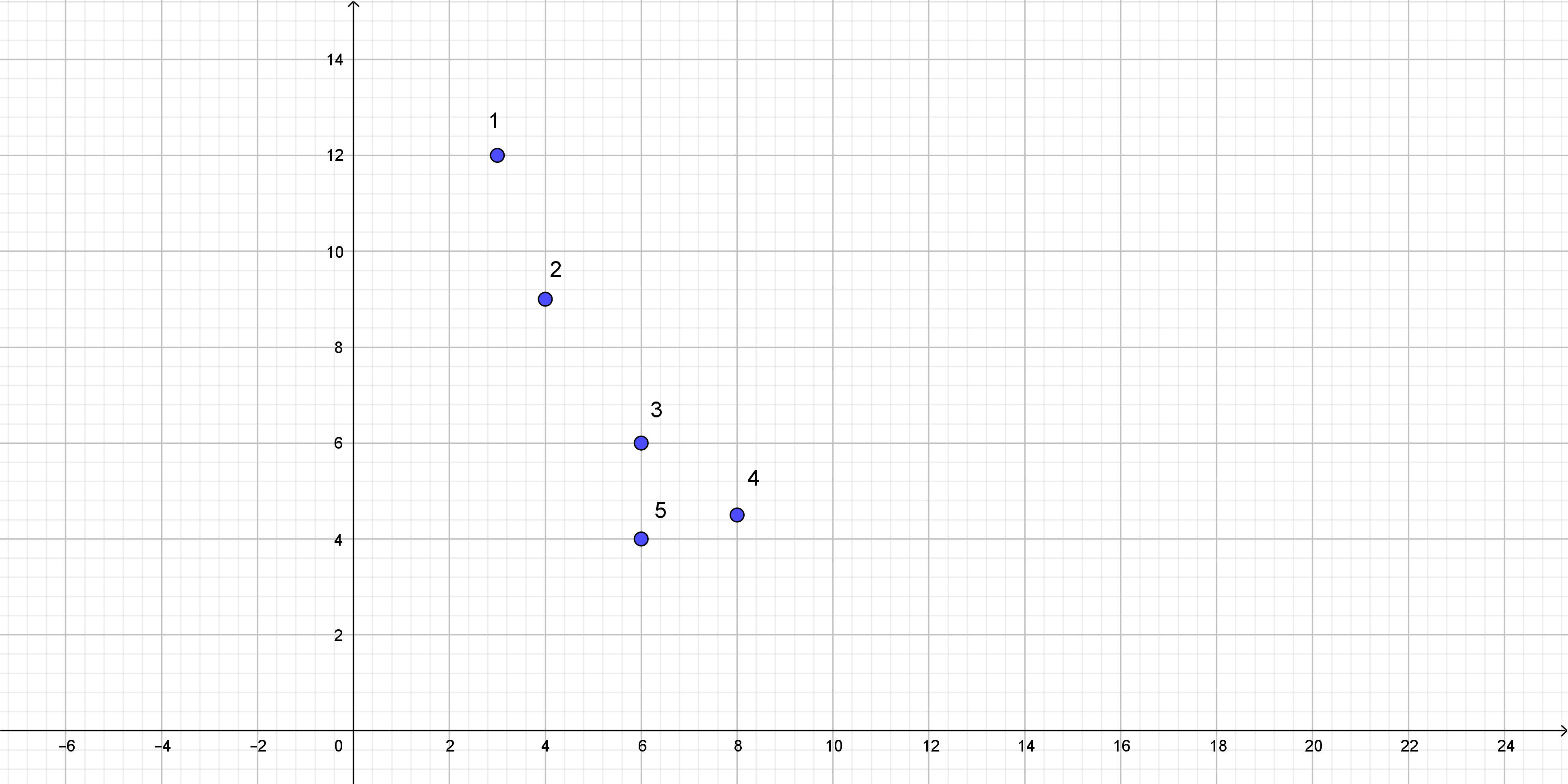
For unmatched point, base is $6$ and height is $4$, so, the area is $6cdot4=24$ square units.
#### (c)
This point should not be on Cairo’s graph because its area is not $36$ square units.
#### (d)
The dimensions of three more rectangles are:
$1$ unit by $36$ units
$2$ units by $18$ units
$5$ units by $7.2$ units
Those points are on the following picture:

On the following picture there is required figure: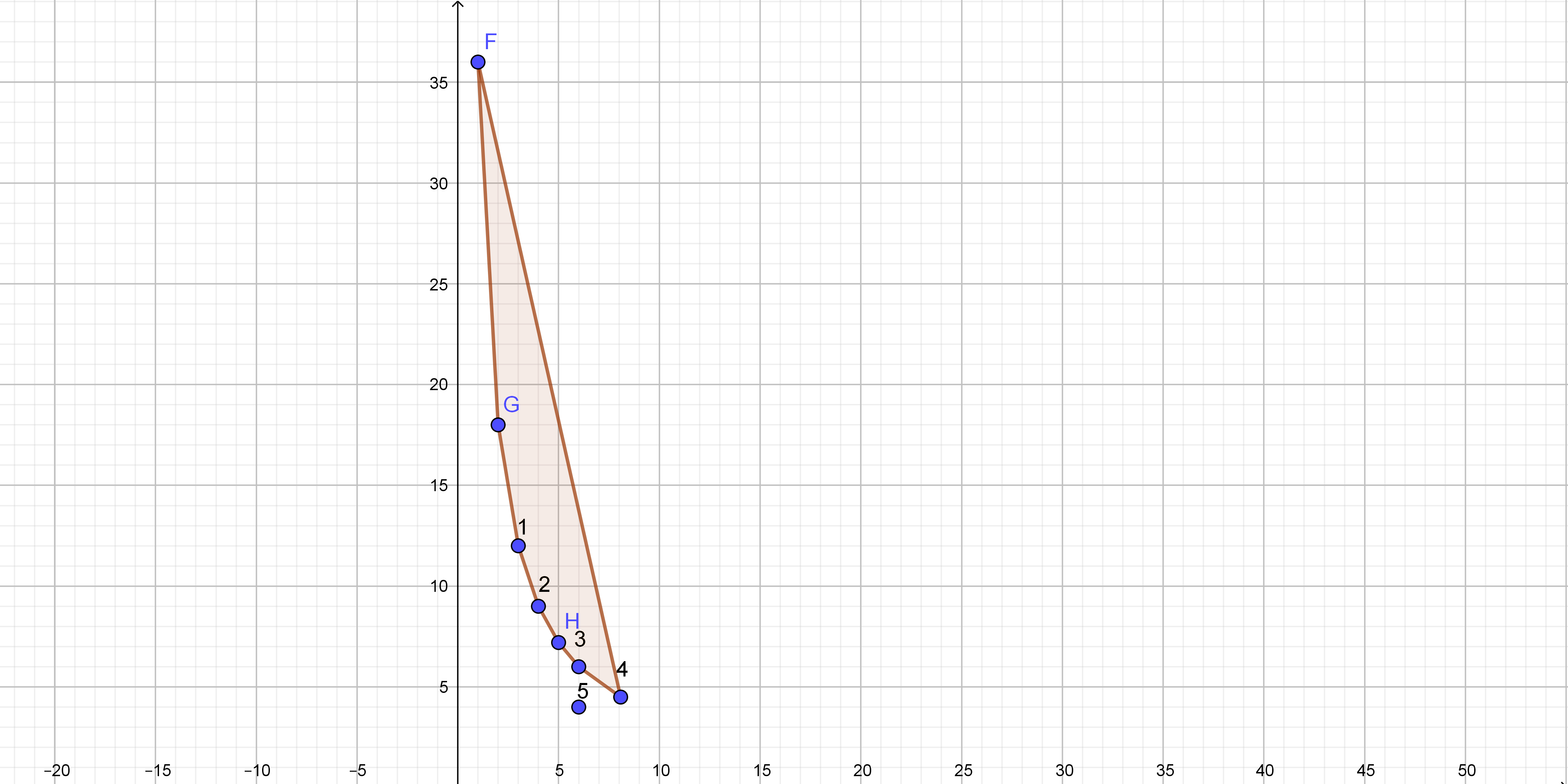
$$
Largecolor{#4257b2}text{(a)} x^3 x^-2
$$
$$
Large x^3 x^{-2}=x^{[3+(-2)]}=x^{(3-2)}=x^1=x
$$
$$
Largecolor{#4257b2}text{(b)} dfrac{y^5}{y^-2}
$$
$$
Large dfrac{y^5}{y^{-2}}=y^5 cdot y^{-(-2)}=y^5 cdot y^2=y^{(5+2)}=y^7
$$
$$
Largecolor{#4257b2}text{(c)} 4^{-1}
$$
$$
Large 4^{-1}=dfrac{1}{4}=0.25
$$
$$
Largecolor{#4257b2}text{(d)} (4x^2)^3
$$
$$
Large (4x^2)^3=4^3 cdot (x^2)^3=64 cdot x^2cdot x^2cdot x^2=64 x^{(2+2+2)}=64 x^6
$$
(c) $0.25$ (d) $64 x^6$
The equation which express the information in the game is following:
That is even number, between $0$ and $10$, divisible by $3$.
#### (b)
Between $0$ and $10$: $0, 1, 2, 3, 4, 5$…
Even number: $2, 4, 6, 8$
Divisible by $3$: $6$
So, solution is number $6$.
#### (c)
You can repeat all those steps in order to analyze Game $#4$ algebraically.
$$
color{#4257b2}text{(a)} 4x-5=x-5+3x
$$
Isolate the variables on the left side as follows:
$$
4x-3x-x=-5+5 4x-4x=-5+5
$$
$$
0=0 text{No solution}
$$
$$
color{#4257b2}text{(b)} -x-4x-7=-2x+5
$$
Isolate the variables on the left side as follows:
$$
-x-4x+2x=5+7 -3x=12
$$
$$
x=dfrac{12}{-3} x=-4
$$
$$
color{#4257b2}text{(c)} 3+5x-4-7x=2x-4x+1
$$
Isolate the variables on the left side as follows:
$$
5x-7x-2x+4x=1+4-3
$$
$$
0=2 text{No solution}
$$
color{#4257b2}text{(d)} 4x-(-3x+2)=7x-2
$$
Change subtraction to adding the opposite as follows:
$$
4x+3x-2=7x-2
$$
Isolate the variables on the left side as follows:
$$
4x+3x-7x=-2+2 7x-7x=-2+2
$$
$$
0=0 text{No solution}
$$
$$
color{#4257b2}text{(e)} x+3+x+3=-(x+4)+(3x-2)
$$
Change subtraction to adding the opposite as follows:
$$
x+3+x+3=-x-4+3x-2
$$
Isolate the variables on the left side as follows:
$$
x+x+x-3x=-4-2-3-3 3x-3x=-12
$$
$$
0=-12 text{No solution}
$$
$$
color{#4257b2}text{(f)} x-5-(2-x)=-3
$$
Change subtraction to adding the opposite as follows:
$$
x-5-2+x=-3
$$
Isolate the variables on the left side as follows:
$$
x+x=-3+5+2 2x=4
$$
$$
x=dfrac{4}{2} x=2
$$
(c) No solution (d) No solution
(e) No solution (f) $x=2$
$$
color{#4257b2}text{(a)} 2-2x-(4-x)=2-3-(2x-2)
$$
Change subtraction to adding the opposite as follows:
$$
2-2x-4+x=2-3-2x+2
$$
Isolate the variables on the left side as follows:
$$
-2x+x+2x=2-3+2+4-2 x=3
$$
$text{color{#4257b2}Check:}$ substitute the value of $x=3$ in the equation as follows:
$$
2-(2cdot3)-(4-3)=2-3-(2 cdot3-2) 2-6-1=2-3-4 -5=-5
$$
Since the left side is equal the right side, so the answer is correct.
$$
color{#4257b2}text{(b)} x+1-2-(3-x)=6-(1+2x-1)
$$
Change subtraction to adding the opposite as follows:
$$
x+1-2-3+x=6-1-2x+1
$$
Isolate the variables on the left side as follows:
$$
x+x+2x=6-1+1+3+2-1 4x=10
$$
$$
x=dfrac{10}{4} x=dfrac{5}{2} x=2.5
$$
$text{color{#4257b2}Check:}$ substitute the value of $x=dfrac{5}{2}$ in the equation as follows:
$$
2.5+1-2-(3-2.5)=6-(1+2 cdot2.5-1) 2.5+1-2-0.5=6-5 1=1
$$
Since the left side is equal the right side, so the answer is correct.
text{color{#4257b2}(a) $x=3$ (b) $x=2.5$}
$$
$$
color{#4257b2}text{(a)} 3x-7+9-2x=x+2
$$
Isolate the variables on the left side as follows:
$$
3x-2x-x=2-9+7 -3x+3x=-7+7
$$
$$
0=0 text{No solution}
$$
$$
color{#4257b2}text{(b)} -2m+8+m+1=0
$$
Isolate the variables on the left side as follows:
$$
-2m+m=-1-8 -m=-9 m=9
$$
$text{color{#4257b2}Check:}$ substitute the value of $x=9$ in the equation as follows:
$$
(-2cdot9)+8+9+1=0 -18+8+9+1=0 0=0
$$
Since the left side is equal the right side, so the answer is correct.
color{#4257b2}text{(c)} 2=x+6-2x
$$
Isolate the variables on the left side as follows:
$$
-x+2x=6-2 x=4
$$
$text{color{#4257b2}Check:}$ substitute the value of $x=4$ in the equation as follows:
$$
2=4+6-(2cdot4) 2=4+6-8 2=10-8 2=2
$$
Since the left side is equal the right side, so the answer is correct.
$$
color{#4257b2}text{(d)} 0.5p=p+5
$$
Isolate the variables on the left side as follows:
$$
0.5p-p=5 -0.5p=5 p=dfrac{5}{-tfrac{1}{2}}
$$
$$
p=5 cdot-2 p=-10
$$
$text{color{#4257b2}Check:}$ substitute the value of $p=-10$ in the equation as follows:
$$
0.5 cdot(-10)=-10+5 -5=-5
$$
Since the left side is equal the right side, so the answer is correct.
(c) $x=4$ (d) $p=-10$
text{color{#4257b2}We need to know how many students attend east high school?}
$$
Let Assume that the student at east high school is $x$ and student
in west high school is $x-250$
Total students can be represented by $color{#4257b2}2858=x-250+x$
$$
2x-250=2858
$$
Isolate the variables on the left side as follows:
$$
2x=2858+250 2x=3108 x=dfrac{3108}{2}
$$
$$
x=1554
$$
The student in the east high school is $color{#4257b2}1554$ students.
$$
color{#4257b2}text{(a)} -3+2x=-x+6
$$
Isolate the variables on the left side as follows:
$$
2x+x=6+3 3x=9
$$
$$
x=dfrac{9}{3} x=3
$$
$text{color{#4257b2}Check:}$ substitute the value of $x=3$ in the equation as follows:
$$
-3+(2cdot3)=-3+6 -3+6=-3+6 3=3
$$
Since the left side is equal the right sidem, so the answer is correct.
$$
color{#4257b2}text{(b)} 5-3x=x+1
$$
Isolate the variables on the left side as follows:
$$
-3x-x=1-5 -4x=-4
$$
$$
x=dfrac{-4}{-4} x=1
$$
$text{color{#4257b2}Check:}$ substitute the value of $x=1$ in the equation as follows:
$$
5-(3cdot1)=1+1 5-3=2 2=2
$$
Since the left side is equal the right side, so the answer is correct.
color{#4257b2}text{(c)} -2x=4x+9
$$
Isolate the variables on the left side as follows:
$$
-2x-4x=9 -6x=9
$$
$$
x=dfrac{9}{-6} x=dfrac{-3}{2} x=-1.5
$$
$text{color{#4257b2}Check:}$ substitute the value of $x=-1.5$ in the equation as follows:
$$
-2cdot-1.5=(4cdot-1.5)+9 3=-6+9 3=3
$$
Since the left side is equal the right side, so the answer is correct.
$$
color{#4257b2}text{(d)} 4x+3=x
$$
Isolate the variables on the left side as follows:
$$
4x-x=-3 3x=-3
$$
$$
x=dfrac{-3}{3} x=-1
$$
$text{color{#4257b2}Check:}$ substitute the value of $x=-1$ in the equation as follows:
$$
(4cdot-1)+3=-1 -4+3=-1 -1=-1
$$
Since the left side is equal the right side, so the answer is correct.
(c) $x=-1.5$ (d) $x=-1$
$$
color{#4257b2}text{(a)} dfrac{5}{4}+dfrac{7}{16}
$$
$$
=dfrac{(5cdot16)+(4cdot7)}{16cdot4}=dfrac{80+28}{64}=dfrac{108}{64}=1.6875
$$
$$
color{#4257b2}text{(b)} -dfrac{10}{13} cdot dfrac{5}{11}
$$
$$
=dfrac{(5cdot-10)}{11cdot13}=dfrac{-50}{143}=-0.3496
$$
$$
color{#4257b2}text{(c)} dfrac{9}{11}+dfrac{-20}{21}
$$
$$
=dfrac{(9cdot21)+(11cdot-20)}{21cdot11}=dfrac{189-220}{231}=dfrac{-31}{231}=-0.1342
$$
$$
color{#4257b2}text{(d)} dfrac{-8}{3}+dfrac{-5}{18}
$$
$$
=dfrac{(-8cdot18)+(3cdot-5)}{18cdot3}=dfrac{-144-15}{54}=dfrac{-159}{54}=-2.9444
$$
(c) $-0.1342$ (d) $-2.9444$
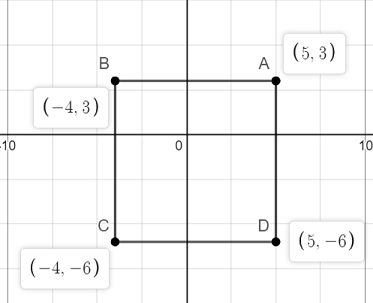
Therefore, it is a $text{textcolor{#4257b2}{square}}$.
$textbf{(b)}$ Length of each side of quadrilateral is $|3-(-6)|=textcolor{#4257b2}{9 textrm{ units}}$
$textbf{(c)}$ Area of square is square of the side, therefore area($A$) of quadrilateral is:
$$
A=(9)^2=81textrm{ unit}^2
$$
$textbf{(d)}$ Perimeter of square is 4 times the side, therefore perimeter($P$) of quadrilateral is:
$$
P=4 times 9=36textrm{ units}
$$
$$
y=6cdot50+3
$$
$$
y=303
$$
Conclusion is that there will be $303$ tiles in Figure $50$.
Conclusion is that we suppose to supstitute $45$ for $y$ in order to solve Lew’s problem.
#### (b)
An equation which is needed to be solved for $x$ is following:
$$
45=6x+3
$$
We will solve it on that way we will isolate $x$ and get:
$$
6x=42
$$
$$
x=7
$$
So, conclusion is that “Big $7$’s” figure is made up of $45$ tiles.
#### (c)
We can check it substituting $7$ for $x$ in original equation:
$$
y=6cdot7+3
$$
$$
y=45
$$
We got $y=45$, which is supposed to be gotten, our solution is correct.
$$
84=6x+3
$$
$$
6x=81
$$
$$
x=13.5
$$
Conclusion is that this solution has no sense because it is not an integer.
$$
824.5=8.5+68x
$$
$$
68x=816
$$
$$
x=12
$$
Girls bought $12$ tickets.
In order to check our solution, we will substitute $12$ for $x$ and get:
$$
824.5=8.5+68.12
$$
$$
824.5=824.5
$$
So, our solution is correct.
$$
color{#4257b2}text{(a)} dfrac{1}{2} x-2=x-4
$$
Isolate the variables on the left side as follows:
$$
dfrac{1}{2}x-x=-4+2 -dfrac{1}{2}x=-2
$$
Multiply both sides of equation by $-2$ as follows.
$$
left(-dfrac{1}{2} cdot -2right)x=-2cdot-2 x=4
$$
$text{color{#4257b2}Check:}$ substitute the value of $x=4$ in the equation as follows:
$$
dfrac{1}{2}cdot4-2=4-4 2-2=4-4 0=0
$$
Since the left side is equal the right side, so the answer is correct.
$$
color{#4257b2}text{(b)} 8-0.25x=0.5x+2
$$
Isolate the variables on the left side as follows:
$$
-0.25x-0.5x=2-8 -0.75x=-6
$$
$$
x=dfrac{-6}{-0.75} x=8
$$
$text{color{#4257b2}Check:}$ substitute the value of $x=8$ in the equation as follows:
$$
8-(0.25cdot8)=(0.5cdot8)+2 8-2=4+2 6=6
$$
Since the left side is equal the right side, so the answer is correct.
color{#4257b2}text{(c)} x+2-0.5x=1+0.5x+1
$$
Isolate the variables on the left side as follows:
$$
x-0.5x-0.5x=1+1-2 x-x=2-2
$$
$$
0=0 text{No solution}
$$
$$
color{#4257b2}text{(d)} 7x-0.15=2x+0.6
$$
Isolate the variables on the left side as follows:
$$
7x-2x=0.6+0.15 5x=0.75
$$
$$
x=dfrac{0.75}{5} x=0.15
$$
$text{color{#4257b2}Check:}$ substitute the value of $x=0.15$ in the equation as follows:
$$
(7cdot0.15)-0.15=(2cdot0.15)+0.6 1.05-0.15=0.3+0.6 0.9=0.9
$$
Since the left side is equal the right side, so the answer is correct.
(c) No solution (d) $x=0.15$
We will solve this equation on following way:\
$$1.6x=4$$\
$$x=2.5$$\
Now, substitute $2.5$ for $x$ in equation and get:\
$$5=1.6cdot2.5+1$$\
$$5=5$$\
So, our solution is correct.\
subsection*{(b)}
Completed table for given rule is following:\
begin{center}
begin{tabular}{ |c|c| c| c| c| c |c| }
hline
$x$ & $y$ \
hline
$-1$ & $-0.6$\
hline
$0$ & $1$\
hline
$1$ & $2.6$\
hline
$2$ & $4.2$\
hline
end{tabular}
end{center}
On the following picture there is graphed the line $y=1.6x+1$:\

From previous picture, we can notice that required value of $x$ is $2.5$ and it is the same result as in part (a).
$$
color{#4257b2}text{(a)} 3x-7=3x+1
$$
Isolate the variables on the left side as follows:
$$
3x-3x=1+7 0=8 text{ No solution}
$$
$$
color{#4257b2}text{(b)} -2x-5=-4x+2
$$
Isolate the variables on the left side as follows:
$$
-2x+4x=2+5 2x=7
$$
$$
x=dfrac{7}{2} x=3.5
$$
$text{color{#4257b2}Check:}$ substitute the value of $x=3.5$ in the equation as follows:
$$
(-2cdot3.5)-5=(-4cdot3.5)+2 -7-5=-14+2 -12=-12
$$
Since the left side is equal the right side, so the answer is correct.
color{#4257b2}text{(c)} 2+3x=x+2+2x
$$
Isolate the variables on the left side as follows:
$$
3x-x-2x=2-2 0=0 text{ No solution}
$$
$$
color{#4257b2}text{(d)} -(x-2)=x+2
$$
Change subtraction to adding the opposite as follows:
$$
-x+2=x+2
$$
Isolate the variables on the left side as follows:
$$
-x-x=2-2 -2x=0 x=0
$$
$text{color{#4257b2}Check:}$ substitute the value of $x=0$ in the equation as follows:
$$
-(0-2)=0+2 -(-2)=2 2=2
$$
Since the left side is equal the right side, so the answer is correct.
(c) No solution (d) $x=0$
$$
color{#4257b2}text{(a)} 1-3-(-2x)=-x-3-(2+x)
$$
Change subtraction to adding the opposite as follows:
$$
1-3+2x=-x-3-2-x
$$
Isolate the variables on the left side as follows:
$$
2x+x+x=-3-2+3-1 4x=-3
$$
$$
x=dfrac{-3}{4} x=-0.75
$$
$text{color{#4257b2}Check:}$ substitute the value of $x=0.75$ in the equation as follows:
$$
1-3-(-2cdot-0.75)=-(-0.75)-3-(2-0.75) 1-3-1.5=0.75-3-1.25 -3.5=-3.5
$$
Since the left side is equal the right side, so the answer is correct.
$$
color{#4257b2}text{(b)} 1+y-1-(-2)=3+y-(1-y)
$$
Change subtraction to adding the opposite as follows:
$$
1+y-1+2=3+y-1+y
$$
Isolate the variables on the left side as follows:
$$
y-y-y=3-1-2+1-1 -y=0 y=0
$$
$text{color{#4257b2}Check:}$ substitute the value of $x=0$ in the equation as follows:
$$
1+0-1-(-2)=3+0-(1-0) 1-1+2=3-1 2=2
$$
Since the left side is equal the right side, so the answer is correct.
color{#4257b2}text{(c)} 1-4-x-(4-1)=-x-2-(4)
$$
Change subtraction to adding the opposite as follows:
$$
1-4-x-4+1=-x-2-4
$$
Isolate the variables on the left side as follows:
$$
-x+x=-2-4-1+4+4-1 0=-8+8 0=0
$$
No solution
text{color{#4257b2}(a) $x=-0.75$ (b) $y=0$
\ \
(c) No solution}
$$
begin{center}
begin{tabular}{ |c|c| c| c| c| c |c| }
hline
$text{Left Expression}$ & $text{Right Expression}$ & $text{Explanation}$ \
hline
$3x^2-(2x-4)$ & $3+3x^2+1$ & $text{Starting expression}$ \
hline
$3x^2+(-2x)+4$ & $3+3x^2+1$ & $text{Distributive rule}$ \
hline
$-2x+4$ & $4$ & $text{Remove $3x^2$ from both sides}$ \
hline
$-2x$ & $0$ & $text{Remove $4$ from both sides}$ \
hline
$x$ & $0$ & $text{Divide both sides by $-2$}$ \
hline
end{tabular}
end{center}
So, we got that solution of the equation is $x=0$.\
$$
color{#4257b2}text{(a)} 30-2x text{When} x=-6
$$
Substitute the value of $x=-6$ in the equation as follows:
$$
30-(2cdot-6)=30-(-12)=30+12=42
$$
$$
color{#4257b2}text{(b)} x^2+2x text{When} x=-3
$$
Substitute the value of $x=-3$ in the equation as follows:
$$
(-3)^2+(2cdot-3)=9+(-6)=9-6=3
$$
$$
color{#4257b2}text{(c)} – dfrac{1}{2} x+9 text{When} x=-6
$$
Substitute the value of $x=-6$ in the equation as follows:
$$
-dfrac{1}{2}cdot-6+9=-dfrac{-6}{2}+9=-(-3)+9=3+9=12
$$
$$
color{#4257b2}text{(d)} sqrt{k} text{When} k=9
$$
Substitute the value of $x=9$ in the equation as follows:
$$
sqrt{9}=sqrt{3cdot3}=3
$$
(c) $12$ (d) $3$
Assume the width of rectangle is $color{#4257b2}x$ and length is $color{#4257b2}3+2x$
Total perimeter is $78$ cm. $78=x+3+2x+x+3+2x$
Add similar group like terms as follows:
$$
6x+6=78 6x=78-6 6x=72
$$
Divide the both side by $6$ as follows:
$$
x=dfrac{72}{6}=12 x=12
$$
Width of the rectangle is $12$ cm, and length is $3+(2cdot12)=3+24=27$ cm.
$text{color{#4257b2}Check:}$ Substitute the value of $x$ in the perimeter equation as follows:
$$
78=12+3+(2cdot12)+12+3+(2cdot12) 78=12+3+24+12+3+24=78
$$
Since the left side is equal the right side, so the answer is correct.
text{color{#4257b2}Width $=12$ cm Length $=27$ cm}
$$
$$
x+x+3+2x-5=78
$$
$$
4x-2=78
$$
$$
4x=80
$$
$$
x=20
$$
So, there were $20$ Schnauzers, $23$ Scotties and $35$ Wirehaired Terriers.

